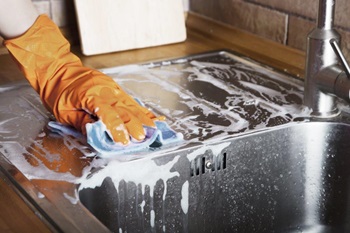Ashley Eisenbeiser, MS, CFS, Director, Food and Product Safety Programs, Food Marketing Institute
 There has been a dramatic change in the grocery industry over the last couple of years. This change is not only being seen in consumer purchasing decisions but also in the design of stores. Retailers are trying to meet consumers’ increasing demand for convenience and fresh while trying to enhance the shopping experience. Stores are transforming—center aisles are shrinking while fresh and fresh-prepared departments are expanding. Companies are exploring how they can differentiate themselves by expanding prepared food offerings, enhancing customer engagement, and embarking on store redesigns. Establishing relationships with stakeholders ensures food safety and sanitary design remains the foundation of any business decision made in your store.
There has been a dramatic change in the grocery industry over the last couple of years. This change is not only being seen in consumer purchasing decisions but also in the design of stores. Retailers are trying to meet consumers’ increasing demand for convenience and fresh while trying to enhance the shopping experience. Stores are transforming—center aisles are shrinking while fresh and fresh-prepared departments are expanding. Companies are exploring how they can differentiate themselves by expanding prepared food offerings, enhancing customer engagement, and embarking on store redesigns. Establishing relationships with stakeholders ensures food safety and sanitary design remains the foundation of any business decision made in your store.
Poor sanitary design coupled with poor cleaning and sanitation practices can lead to harborage areas where pathogens can survive, increasing the risk of contamination. FDA’s risk factor study identifies contaminated equipment as one of the major risk factors that contribute to foodborne illness. Whether you are making changes to your facility, equipment, or operations, there are risks associated with sanitary design. Developing robust equipment and facility designs in your store can reduce the risk of foodborne illness and makes cleaning easy and sanitary conditions that can be maintained.
Some examples of where sanitary design should be considered:
- Food contact surfaces are made of corrosion resistant materials
- Equipment seams are smooth and durable
- Walls, floors and ceilings are in good repair
- Floor is slopped toward a drain
- Equipment is elevated off the floor
- Handwashing sinks are located in area that is convenient
- Equipment installed away from the walls
- Ventilation is constructed to prevent drip and condensate
Communicating and collaborating with stakeholders is essential to ensuring sanitary design is incorporated into your establishment. By working with stakeholders from the beginning, it allows:
- Sanitary design principles to be applied ahead of time rather than after the fact.
- Stakeholders to understand the potential risk and to assist with the development of practices and procedures to ensure that the facility and equipment are properly maintained to prevent contamination from occurring.
- Stakeholders are able to work together to overcome concerning issues.
- For a more standardized process.
Are you interested in learning more about sanitary design principles and how you can apply them to your facility?
Plan to attend the 2017 SQF International Conference where you can collaborate with your peers and hear from industry experts to get the best practices and tools you need to address the tough issues associated with maintaining sanitary conditions. This year’s conference will be held November 7-9 in Dallas, TX. For more information or to register, visit www.sqfconference.com.


 Industry Topics address your specific area of expertise with resources, reports, events and more.
Industry Topics address your specific area of expertise with resources, reports, events and more.
 Our Research covers consumer behavior and retail operation benchmarks so you can make informed business decisions.
Our Research covers consumer behavior and retail operation benchmarks so you can make informed business decisions.
 Events and Education including online and in-person help you advance your food retail career.
Events and Education including online and in-person help you advance your food retail career.
 Food Safety training, resources and guidance that help you create a company food safety culture.
Food Safety training, resources and guidance that help you create a company food safety culture.
 Government Affairs work — federal and state — on the latest food industry policy, regulatory and legislative issues.
Government Affairs work — federal and state — on the latest food industry policy, regulatory and legislative issues.
 Get Involved. From industry awards to newsletters and committees, these resources help you take advantage of your membership.
Get Involved. From industry awards to newsletters and committees, these resources help you take advantage of your membership.
 Best practices, guidance documents, infographics, signage and more for the food industry on the COVID-19 pandemic.
Best practices, guidance documents, infographics, signage and more for the food industry on the COVID-19 pandemic.
